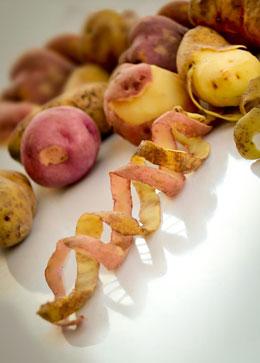Source: Lancaster Farming
Potato breeding doesn’t turn out a lot of winners. A breeder may find something with commercial value in just 1 out of 200,000 plants.
Jeffrey Endelman is trying to improve those odds through the same genomic strategies used in the livestock industry.
Endelman, who runs the University of Wisconsin’s potato breeding program, spoke at the Mid-Atlantic Fruit and Vegetable Convention on Jan. 31 at the Hershey Lodge.
Potato breeders typically stick with a particular parent for several years, so the goal is to pick a good one, and pick it as fast as possible.
 “It’s like interest. It compounds over time because the cycle is getting shorter,” Endelman said.
“It’s like interest. It compounds over time because the cycle is getting shorter,” Endelman said.
Endelman has adopted the genomics approach used by dairy farmers and other livestock producers.
Genomics uses genetic and historical data about an organism’s ancestors to predict how it will perform.
Dairy farmers have used this strategy to, for instance, rapidly increase the percentage of butterfat in milk.
But dairy genomics draws on data from millions of cows.
Endelman has data on just 600 clones and 5,000 DNA markers in potato-chip varieties, and even fewer for russets and red potatoes.
The traits he’s interested in for the chipping varieties include yield, median weight and color when fried.
“The more traits you stack, the probability of finding something which is excellent in all regards goes down with each one in an exponential way,” Endelman said.
None of the clones in his dataset is in the top 20 percent for all traits, and only five are in the top 30 percent.
Varieties developed through this genomics process are probably still a decade or two away from commercialization, Endelman said.
Having accurate pedigree charts, or potato family trees, is essential to forecasting breeding values correctly.
But using genomics, Endelman has discovered more than 30 errors in potato pedigrees.
Hodag, a potato variety named for a mythical creature from the North Woods of Wisconsin, was thought to be a cross between Pike and an experimental cultivar.
Scatter plots of genomic data showed instead that Dakota Pearl was the father of Hodag — the sort of paternity-test shocker worthy of a daytime talk show.
Most of the errors Endelman found likely came from mistakes in collecting potatoes during the first year of a trial.
“You have 50 or 100,000 plants. Each plant is genetically distinct,” he said.
For some older varieties, pedigrees were incomplete because researchers, mainly interested in the maternal traits, pooled pollen from multiple potato varieties. That practice is now uncommon, Endelman said.
Desirable traits are well defined for processing varieties, but methods for evaluating fresh-market potatoes have long been, in Endelman’s words, stuck in the Dark Ages.
“You say that looks like a good-looking potato, and that’s about as far as it goes,” he said.
Endelman has started to quantify and fine-tune that approach using computer analysis of photos of the potatoes.
He’s been able to quantify how well a potato keeps its skin — a nicked-up spud is unappealing — and to distinguish the colors of different varieties — red potatoes can skew toward magenta or dark burgundy.
The next step is to look for genes that affect color and combine that information with the imagery data to select for color qualities using genomics.